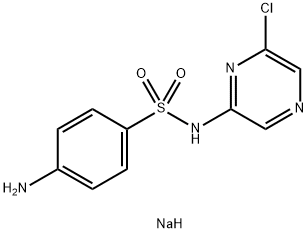23307-72-4
 23307-72-4 結(jié)構(gòu)式
23307-72-4 結(jié)構(gòu)式
基本信息
((4-氨基苯基)磺酰基)(6-氯吡嗪-2-基)酰胺鈉
Sulfaclozine sodium monohydrate
sodium N-(6-chloropyrazinyl)sulphanilamidate
Sodium ((4-aminophenyl)sulfonyl)(6-chloropyrazin-2-yl)amide
4-Amino-N-(6-chloro-2-pyrazinyl)benzenesulfonamide sodium salt
物理化學性質(zhì)
常見問題列表
Bacterial; Parasite
The elimination of Sulfaclozine in the three systems: UV/TiO 2 , UV/K 2 S 2 O 8 , and UV/TiO 2 /K 2 S 2 O 8 . Sulfaclozine is weakly adsorbed on the surface of TiO 2 at pH 7 (< 5%) but efficiently eliminated with the following three systems: UV/TiO 2 , UV/K 2 S 2 O 8 , and UV/TiO 2 /K 2 S 2 O 8 in ultra pure water. Moreover, 12 of Sulfaclozine by-products are identified and reaction pathways show that, in addition of ? OH and SO 4 ?? radicals, the conduction-band electrons are responsible for the formation of some main by-products either directly or by the formation of superoxide radicals.
Sulfaclozine (60 mg/kg; intravenous injection or oral administration; male broiler chickens) can be used primarily for the treatment of parasitic and microbial infections of the digestive tract rather than for the treatment of systemic infections.
| Animal Model: | 14 male broiler chickens (30-day-old) |
| Dosage: | 60 mg/kg |
| Administration: | Intravenous injection or oral administration (Pharmacokinetic Analysis) |
| Result: | Serum drug concentrations at 0.083, 0.50, 2, 6, 24 and 72h were determined to be 99.62, 83.50, 72.68, 58.43, 38.66 and 13.14 μg/mL, respectively, by intravenous injection. By oral administration were determined as 4.33, 7.95, 16.46, 22.88, 16.03 and 5.74 μg/mL, respectively. |